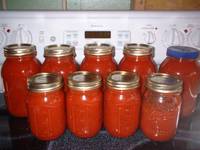 I canned a total of 4 bushels of those big heavy deep-red tomatoes (not counting the smaller tomatoes which are better canned whole or used raw in salsa). Quite expectedly I experimented with different recipes for pasta or spaghetti sauces. After several experimentations, I came to the conclusion that the easiest thing is to make them all into standard tomato sauce, then just add the other ingredients to convert them into pasta sauce according to my taste. You see, this recipe here does not give the taste that I really want, because most of the concern of the developer of these recipes is to come up with a mixture that will ensure the pH that will least encourage the growth of Clostridium botulinum. I mixed together 1 pint of standard tomato sauce with a pint of Italian Seasoned Tomato Sauce and came up with the most delicious yummy pasta sauce I have ever had. The procedure is actually quite standard, with variations only in the style of cooking (stewed tomatoes prepared differently from pasta sauces). So for purposes of demonstration, I am featuring this here. My personal preference at the end of my canning season is just to make standard tomato sauce then add ingredients as I cook the meal. The standard tomato sauce is easier to prepare, requires no other veggies so it maintains its acidity and therefore is not subject to dangers of botulism. For more information on preserving tomatoes, click here.
I canned a total of 4 bushels of those big heavy deep-red tomatoes (not counting the smaller tomatoes which are better canned whole or used raw in salsa). Quite expectedly I experimented with different recipes for pasta or spaghetti sauces. After several experimentations, I came to the conclusion that the easiest thing is to make them all into standard tomato sauce, then just add the other ingredients to convert them into pasta sauce according to my taste. You see, this recipe here does not give the taste that I really want, because most of the concern of the developer of these recipes is to come up with a mixture that will ensure the pH that will least encourage the growth of Clostridium botulinum. I mixed together 1 pint of standard tomato sauce with a pint of Italian Seasoned Tomato Sauce and came up with the most delicious yummy pasta sauce I have ever had. The procedure is actually quite standard, with variations only in the style of cooking (stewed tomatoes prepared differently from pasta sauces). So for purposes of demonstration, I am featuring this here. My personal preference at the end of my canning season is just to make standard tomato sauce then add ingredients as I cook the meal. The standard tomato sauce is easier to prepare, requires no other veggies so it maintains its acidity and therefore is not subject to dangers of botulism. For more information on preserving tomatoes, click here.Ingredients
3/4 cup chopped onion
3/4 cup chopped celery
4 cloves garlic, minced
2 tablespoons olive oil
20 pounds tomatoes
3 bay leaves
2 tablespoons brown sugar
2 tablespoons oregano
2 tablespoons parsley
1/4 teaspoon crushed red pepper (I lessened the original amount asked for, for my children's sake)1/2 teaspoon black pepper
Bottled lemon juice
Instructions
Prepare Ball® or Kerr®jars and closures according to instructions found in Canning Basics. Since this is a combination of tomatoes plus other vegetables, it is considered low-acid food, and therefore, caution against development of botulism is warranted.
Core and quarter tomatoes.

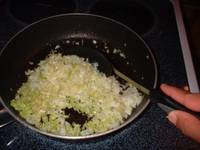
Cook onion, celery and garlic in olive oil, in a large saucepot, until transparent.
Add some of the tomatoes, then transfer this
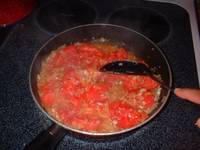
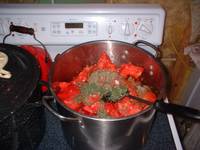
and the remaining ingredients to saucepot.
Simmer mixture about 2 hours, stirring occasionally.
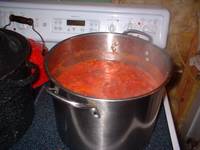
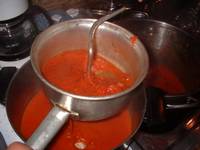
Remove bay leaves. Put tomato mixture through a food mill or sieve to remove seeds and peel.
Return puree to saucepot and cook, uncovered, over medium-high heat until sauce thickens (usually down to half of the original volume of pureed mixture). Stir frequently to prevent sticking.


Add 1 tablespoon bottled lemon juice to each pint jar. Carefully ladle hot sauce into hot jars, leaving 1/4-inch headspace.
Wipe jar rim clean with a damp paper towel or cloth to ensure smooth sealing.


Place lid on jar with sealing compound next to glass.
Screw band down evenly and firmly just until a point of resistance is met-fingertip tight.
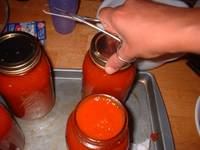
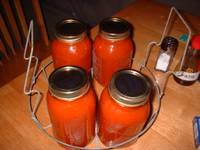
Place in the canning rack and lower into the boiling water. Add more water as needed, making sure that water level is about 2 inches above the lids.
Process at least 40 minutes in a boiling-water canner. Make sure that the water is boiling fully and refrain from opening the canner while processing.
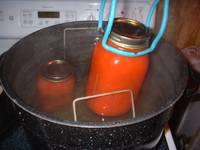

Making sure that there is no draft inside the house, remove the jars one by one from the canner and place on a towel on the countertop, with at least 1 inch space between each jar. Cover with another towel and leave alone for at least 12 hours.
 Check for failure to indent, a sign of non-sealing. This photo is a combination of canned pasta sauce and spaghetti sauce that I made. Notice the jars that are less than the required volume, and the jar with a different cover. I don't bother processing that jar with half the content. I use it up right away. A batch of tomatoes that I process that results only in 1 or 2 quart jars I also do not process anymore. Instead, I place it inside the fridge and consume within 2 weeks. Or I may transfer to a freezer bag and use within 1 year.
Check for failure to indent, a sign of non-sealing. This photo is a combination of canned pasta sauce and spaghetti sauce that I made. Notice the jars that are less than the required volume, and the jar with a different cover. I don't bother processing that jar with half the content. I use it up right away. A batch of tomatoes that I process that results only in 1 or 2 quart jars I also do not process anymore. Instead, I place it inside the fridge and consume within 2 weeks. Or I may transfer to a freezer bag and use within 1 year. Here's how I stack them in the freezer. When I transfer into freezer bags, I squeeze out as much air as I can to create vacuum and lessen the chances of freezer burn. Then, once frozen, I lay them flat on a baking sheet for organized stacking. By then I can stand them upright like books or just pile them up higher.
Here's how I stack them in the freezer. When I transfer into freezer bags, I squeeze out as much air as I can to create vacuum and lessen the chances of freezer burn. Then, once frozen, I lay them flat on a baking sheet for organized stacking. By then I can stand them upright like books or just pile them up higher.I confronted my hubby about whether the quality of the pasta and tomato sauces rivaled those in the grocery store, because if not, I would rather not spend this much time processing these tomatoes. It can be quite tiring and power-consuming. I wanted to see if it was worth the effort. I might be biased, but I love my home-made sauces. Hubby said they were yummy indeed, but if I tire so much canning them, it might still be more cost-effective to buy from the store. (Quite hard to assess whether it was bola or truth. It might be that he did not want to hurt my feelings.) Then recently we watched on History Channel a documentary on how tomatoes are harvested and processed immediately. Oh well...most of my canning this year was out of curiosity on how it was done, on what would be the result (I have no doubt that home-made jams and jellies are better than store-bought, but I doubt that canning veggies are worth the trouble), and having the produce on hand from my garden. I might plan my garden otherwise next year, probably less tomatoes, more berries, same cucumbers, etc. I will probably plant several other veggies good enough for freezer storage for the whole year.


10 comments:
What a wonderful post. I don't can, but I love reading about it. Brings back memories. I'll mention it on my blog, http://collectingmythoughts.blogspot.com.
Excellent photos, clear instructions.
oh WOW! I've gone speechless for a while, you're so handy!!
and without tasting it, I have to agree with your husband...anything that is homemade is far more tastier and better than the ones we buy ready made. One more thing, it ensures us that's it's chemical free.
I wish I can taste your sauce, looks yummy *drooling*...
I can taste it with shrimp in butter and beaten egg.
Uy, may pa align left alight right na siya. Hahaha! Galing galing!
Thess is right, even if canning them is so time consuming you are sure that your tomato sauce is sans chemicals. And I bet better tasting, too. Thanks for posting this Manang, this deserves a bookmark. cheers!
Hi Norma!
Thanks for featuring my blog in yours. I will strive not to disappoint your own blog visis who wuld take a peep into mine through yours.
Thess,
Yeah, it is tastier and heavenly almost, especially knowing that it has no preservative. But I still have a year to see the outcome of my canning: lack of gas formation signifying the growth of C. Botulinum. This year has been one of experiencing and experimenting. The next years will be more on planning. I still hope to be able to continue with canning, that is, if I can find work that is flexible enough to allow gardening (and blogging :) ).
Celia,
Haha! Thanks to your lesson! Sometimes we need a mentor eh. Okay, okay...basing on the encouragements I get here, I might still do canning of tomatoes and other produce by next year. I am currently contemplating on canning pie fillings (cherry, apple, etc.) by next year. Mukang magandang Christmas gift, sabayan ng pie crust recipe sa label, di ba? Si Thess ata nag-spark nung idea na yun.
Wow, Manang this is simply amazing! Perhaps in the future, you may want to consider having your own brand as well, just like the Paul Newman's sauces.
Hello Manang, i was just wondering how long do these canned sauces last and are they okay without refrigeration?
I'm planning to sell spaghetti sauces at bazaars this coming Christmas season and I'm still a newbie as regards canning ingredients. :)
My e-mail is deceptive_whispers@yahoo.com if you feel like imparting some of your wisdom. :) thanks
I canned my 1st batch of pasta sauce yesterday and it seems to have thickened up alot. Should I make it thinner before canning it? Also how tight should rings be? I did fingettip resisstance and one came open, made a mess but the rest sealed. Help if you can!! Thanks Betsy
Hi Betsy,
Kudos to you for trying this!!!
I also do just fingertip tight because that makes it easier for me to loosen the rings once they are sealed. You did fine with just one that spilled. Presuming you used all new lids, probable reasons are: too little headspace (the sauce expands with heat so it might have pushed the lid and some seeds might have gotten caught preventing seal once it was cooling off); or maybe you missed some seeds/spice when you wiped the rim clean prior to placing the lids on.
Another question?? I wanted to can some of my pasta sauce with sweet Italian sausage and was wondering can I can meat using the hot waterbath canner? Betsy
Betsy, as you will see in those links, when you can something with meat, it is advisable to use a pressure canner instead of boiling water bath para mas mataas ang temperature na ma-achieve mo, enough to kill spores which might lead to botulism. Meat, being protein, is alkaline, in contrast to pure tomatoes/veggies which are acidic.
Post a Comment